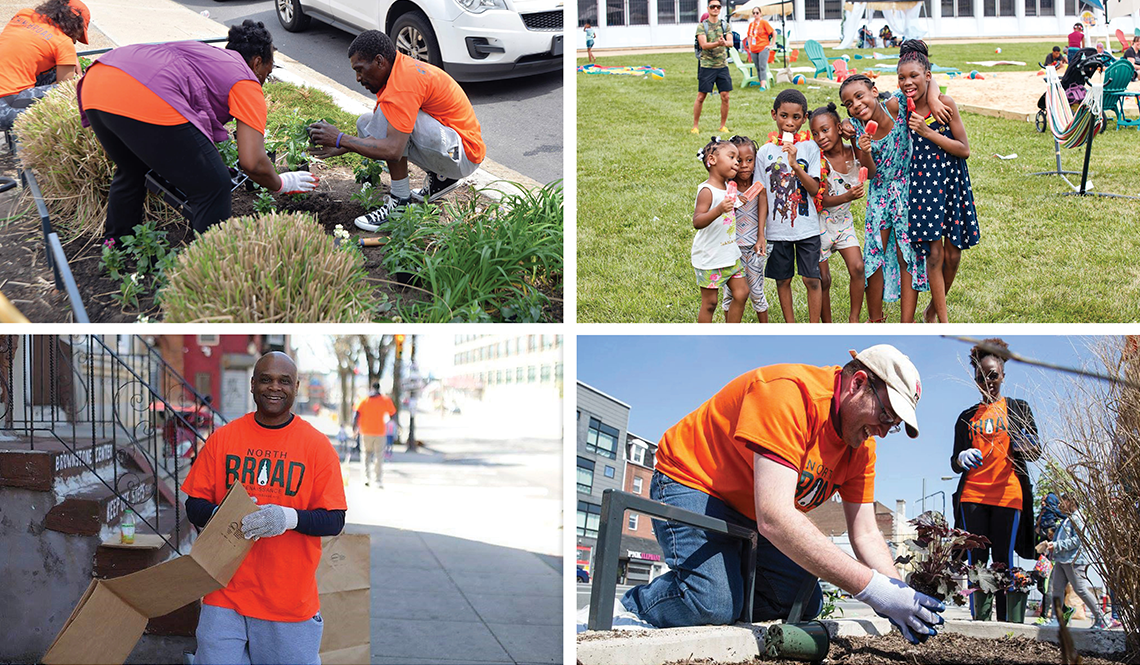
Age-Friendly Philadelphia and Equity
- Select a language for the TTS:
- UK English Female
- UK English Male
- US English Female
- US English Male
- Australian Female
- Australian Male
- Language selected: (auto detect) - EN
Play all audios:
Facebook Twitter Residents maintain North Broad Street planters as part of the Broader Green program in North Philadelphia. The work is part of an effort to improve the economic vitality of
one of the city’s poorest neighborhoods. Photos courtesy North Broad Renaissance The Community
Philadelphia, Pennsylvania, is home to nearly 1.6 million residents, nearly 1 in 4 of whom are age 55 or older. The city is racially and ethnically diverse: 42 percent of the population is
African American, 34 percent is white/non-Hispanic, 15 percent are Hispanic/Latino and 7 percent are Asian.
Partner Organizations A map showing locations of traffic fatalities inPhiladelphia during 2020. Screenshot from Open Data Philly AARP Pennsylvania (and AARP Philadelphia)Bicycle Coalition of Greater PhiladelphiaHispanic Alliance for Career Enhancement
(HACE)North Broad RenaissancePhiladelphia Mayor’s Commission on Aging
Philadelphia joined the World Health Organization Global Network of Age-Friendly Cities and Communities (a precursor to the AARP Network of Age-Friendly States and Communities) in 2012. The
city adopted its age-friendly action plan in 2020.
Community RepresentativesShalimar Thomas, Executive Director, North Broad RenaissanceSarah Clark Stuart, Executive Director, BicycleCoalition of Greater Philadelphia Equity FocusAge-friendly housing, transportation and outdoor spaces The Work
Thomas and Stuart describe efforts to develop and implement the 2020 action plan.
Shifting from “Equality to Equity”
The Philadelphia: An Age-Friendly, Livable City for All plan targets housing, transportation, and outdoor spaces and buildings. The overarching goals in each area are:
To increase thesupply of housing that is accessible, affordable (reflecting neighborhood income) and visitable for people of all agesTo improve the public transit system, increase traffic safety and ensure
that our roads and streets are in a state of good repair and welcoming to people of all ages and backgroundsTo enhance the quality, quantity and accessibility of green spaces in
neighborhoods throughout Philadelphia — and improve the physical infrastructure and programming at public facilities such as libraries and recreation centers
"All people, regardless of income, deserve clean streets, well-maintained green spaces and safe public spaces," says Thomas. "It's a basic quality of life issue and will take thoughtfulness
and intention to ensure that we walk this path."
"Community groups are looking at the recommendations in the action plan and are incorporating them into their strategic plans. Meanwhile, policymakers are determining the role policy will
play, " Thomas adds.
"We've seen COVID-19’s impacts on underserved communities. It shifts the conversation from equality to equity.”
— Shalimar Thomas, North Broad Renaissance
Safer Streets for Seniors and Lower-Income Neighborhoods
“We’ve been deeply involved with the City of Philadelphia's Vision Zero program, which is a multi-agency effort to tackle the public health issue of traffic deaths and reduce them to zero by
2030," Stuart explains. "This issue is of particular importance to the aging community because, according to our analysis of police data, 32 percent of those killed in traffic crashes in
2020 were over 50. Most traffic deaths occurred in census tracts identified as above average for indicators of potential disadvantage, as defined by the Delaware Valley Regional Planning
Commission."
The efforts have raised public awareness about the public health crisis of traffic fatalities. "Before Mayor Jim Kenney made traffic safety a priority, fatal traffic crashes were not being
systematically addressed and there wasn't a focus on the disproportionate impacts in low-income neighborhoods and on communities of color," Stuart says. "Now an intradepartmental task force
is looking at the problem from engineering, planning and education standpoints."
The city's Vision Zero program hasn't yet generated a declining trend in traffic death. "In fact, in 2020, the number of traffic fatalities rose by nearly 80 percent, making it the highest
in 23 years," says Stuart. "There is clearly more work to do.”
Related ResourcesDelaware Valley Regional Planning CommissionPhiladelphia: An Age-Friendly, Livable City for AllVision ZeroPhiladelphia AARP LinksLearn about the AARP Network of Age-Friendly States and CommunitiesCheck out the network's Member ListConnect with AARP Pennsylvania Find Age-Friendly Responses to
COVID-19
More from AARP.org/Livable
Use the dropdown to choose a livability topic.
Select a Subject Select a Subject AARP.org/Livable Home Page AARP Age-Friendly Network AARP Community Challenge AARP Livable CommunitiesNewsletter AARP Livable Map Bicycling Community Engagement Community Health and Wellness Community Resilience Community Diversity Economic Development High-Speed Internet Access Housing
Inspiring Examples Livable Lessons Local Solutions Placemaking Public Places and Outdoor Spaces Rural Livability Social Participation Surveys and Statistics Transportation Walkability
Workshops and Conferences Zoning and Land Use
Visit another community: Age-Friendly Network Communities and Equity
Reported by Mary Kay Bailey | Fall 2020 | Population data from the U.S. Census